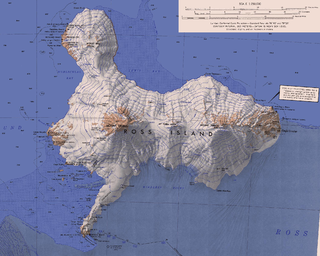


Voyteh Point (Bulgarian : нос Войтех, ‘Nos Voyteh’ \'nos 'voy-teh\) is the point forming the east side of the entrance to Richards Cove on the north coast of Ray Promontory in the northwestern part of Byers Peninsula on Livingston Island in the South Shetland Islands, Antarctica. It is surmounted by Sàbat Hill. The area was visited by early 19th century sealers.

Bulgarian, is an Indo-European language and a member of the Southern branch of the Slavic language family.

Richards Cove is the 450 m wide cove indenting for 550 m the north coast of Ray Promontory, Byers Peninsula, Livingston Island in the South Shetland Islands, Antarctica, entered east of Aglen Point and west of Voyteh Point. The area was visited by early 19th century sealers.

Ray Promontory is the 7 km long and 2.8 km wide promontory lying between Barclay Bay and the New Plymouth sound, and forming the northwest part of Byers Peninsula, Livingston Island in the South Shetland Islands, Antarctica ending up in Start Point and Essex Point. The promontory's interior is mostly occupied by Dospey Heights.
Contents
The feature is part of the Antarctic Specially Protected Area ASPA 126 Byers Peninsula, situated in one of its restricted zones. [1]
An Antarctic Specially Protected Area (ASPA) is an area on the continent of Antarctica, or on nearby islands, which is protected by scientists and several different international bodies. The protected areas were established in 1961 under the Antarctic Treaty System, which governs all the land and water south of 60 latitude and protects against human development. A permit is required for entry into any ASPA site. The ASPA sites are protected by the governments of Australia, New Zealand, United States, United Kingdom, Chile, France, Argentina, Poland, Russia, Norway, Japan, India, Italy, and Republic of Korea. There are currently 72 sites.
The point is named after Georgi Voyteh, Kavhan (hereditary viceroy function) under Czar Konstantin-Petar of Bulgaria (11th Century AD).
A viceroy is an official who runs a country, colony, city, province, or sub-national state, in the name of and as the representative of the monarch of the territory. The term derives from the Latin prefix vice-, meaning "in the place of" and the French word roy, meaning "king". A viceroy's territory may be called a viceroyalty, though this term is not always applied. The adjective form is viceregal, less often viceroyal. The term vicereine is sometimes used to indicate a female viceroy suo jure, although viceroy can serve as a gender-neutral term. Vicereine is more commonly used to indicate a viceroy's wife.

Constantine Bodin was the ruler of Duklja, from 1081 to 1101, succeeding his father, Mihailo Vojislavljević. Born in peaceful times, when the Southern Slavs were subjects of the Byzantine Empire, his father was in 1072 approached by Bulgarian nobility, who sought aid in their revolt against the Byzantines; Mihailo sent them Bodin, who was crowned Bulgarian Tsar under the name Petar III joined the short-lived revolt, being captured the following year after initial success. He was freed in 1078, and upon the death of his father in 1081 he succeeded the throne. Having renewed his acknowledgement of Byzantine overlordship, he soon sided with their enemies, the Normans, which resulted in a Byzantine invasion and his capture. Although he quickly had himself freed, his reputation and influence waned. He was pushed aside by one of his governors, Vukan in Raška, who continued the struggle against the Byzantines.







